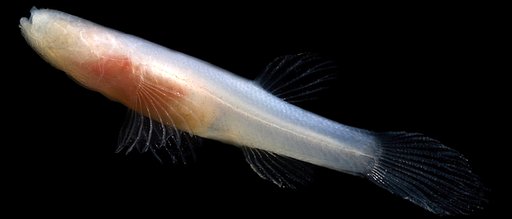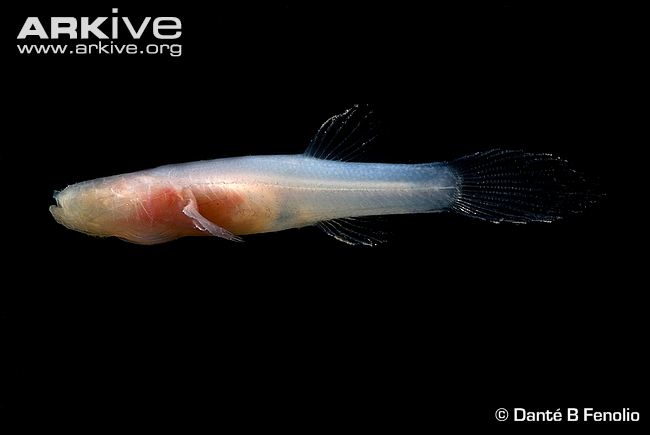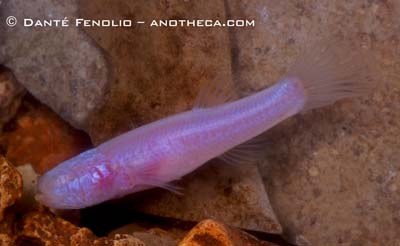
Morphology
The Ozark cavefish (Amblyopsis rosae) is quite small,
reaching a maximum length of merely 65 mm and a mass of only 2.5-3.0
grams, making it optimal for cave navigation (Johnston, 2011). As
this tiny fish traverses the channels of the aquifers of the
Springfield Plateau region, this morphological adaptation allows for
easier travel throughout the connecting caves. When in comparison
with the southern cavefish (Typhlichthys subterraneous), the Ozark
cavefish has been found to be better-suited to the environment than
the southern cavefish when it comes to navigating this environment
(Noltie & Wicks, 2001).
Right: An imge of the A. rosae depicting the loss of eyes and the lateral line that runs the length of the body. Photo courtesy of Danté B Fenolio
This tiny fish has an elongated skull coupled with an
outcurved
lower jaw (Missouri Department of Conservation, 2013).
Morphologically, this fish lacks pelvic fins, a trait commonly lost
in cavefish (for example Typhlichthys subterraneous, Amblyopsis
spelacea, and Speoplatyrhinus poulsoni) (Noltie & Wicks, 2001).
Another notable trait of the Ozark cavefish is the tailfin, which
has evolved a semicircular shape. These adaptations provide the fish
with excellent maneuvering abilities, making the cavefish more adept
for tasks such as feeding and predator evasion.
Furthermore, the A. rosae has lost functionality of the
eyes, which is a characteristic trait of many cavefish, as sight is useless
in these habitats. Although studies have shown a loss in the visual
cortex of the brain (the area of the brain responsible for light
interpretation), they concurrently have indicated a heightened
ability to interpret the senses of hearing and smell in the cavefish to compensate for this loss (Noltie & Wicks, 2001). Along with
the optical sense vanishing in this species, the Ozark cavefish also
lacks melanophores, or tissues responsible for coloration in the skin, resulting in a loss of pigmentation
(Brown & Johnson, 2001; Noltie &Wicks, 2001).
 Nevertheless,
a pink hue can be seen throughout the body of the fish, resulting
from the hue of the internal organs and circulatory system which lie
below the translucent epithelial layers.
Nevertheless,
a pink hue can be seen throughout the body of the fish, resulting
from the hue of the internal organs and circulatory system which lie
below the translucent epithelial layers.
Left: An imge of the Ozark cavfish, note the lack of pigmentation and redish hue produced by the internal organs. Photo courtesy of Danté B Fenolio.
Not only does the Amblyopsis rosae have neural modifications of the brain, but it also has a lateral line, which is a characteristic trait of many aquatic animal lineages. The lateral line possesses the sensory neuromasts, which run along each side of the fish extending onto the head (Noltie & Wicks, 2001). These neuromasts are useful for the detection of proximity, pressure fluctuations, and prey in the surrounding environment, as they utilize specialized mechanoreceptors. The neuromasts of A. rosae span the length of each individual’s body, expanding extensively over the skull, and are also located on the caudal fin of this species. Here they are arranged in a horizontal manner, usually organized into four to six rows (Noltie & Wicks, 2001).
<Return to Habitat and Geography Home Continue to Reproduction>